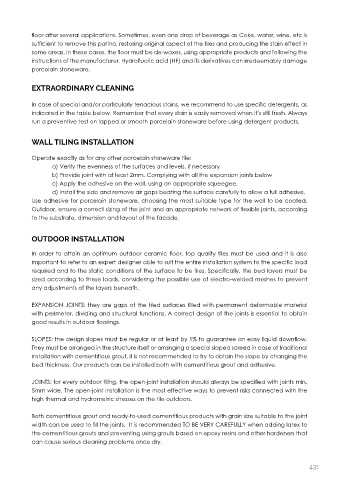Page 431 - Molution General Catalogue 2018
P. 431
floor after several applications. Sometimes, even one drop of beverage as Coke, water, wine, etc is
sufficient to remove this patina, restoring original aspect of the tiles and producing the stain effect in
some areas. In these cases, the floor must be de-waxes, using appropriate products and following the
instructions of the manufacturer. Hydrofluoric acid (HF) and its derivatives can irredeemably damage
porcelain stoneware.
EXTRAORDINARY CLEANING
In case of special and/or particularly tenacious stains, we recommend to use specific detergents, as
indicated in the table below. Remember that every stain is easily removed when it’s still fresh. Always
run a preventive test on lapped or smooth porcelain stoneware before using detergent products.
WALL TILING INSTALLATION
Operate exactly as for any other porcelain stoneware tile:
a) Verify the evenness of the surfaces and levels, if necessary
b) Provide joint with at least 2mm. Complying with all the expansion joints below
c) Apply the adhesive on the wall, using an appropriate squeegee.
d) Install the slab and remove air gaps beating the surface carefully to allow a full adhesive.
Use adhesive for porcelain stoneware, choosing the most suitable type for the wall to be coated.
Outdoor, ensure a correct sizing of the joint and an appropriate network of flexible joints, according
to the substrate, dimension and layout of the facade.
OUTDOOR INSTALLATION
In order to attain an optimum outdoor ceramic floor, top quality tiles must be used and it is also
important to refer to an expert designer able to suit the entire installation system to the specific load
required and to the static conditions of the surface to be tiles. Specifically, the bed layers must be
sized according to these loads, considering the possible use of electro-welded meshes to prevent
any adjustments of the layers beneath.
EXPANSION JOINTS: they are gaps of the tiled surfaces filled with permanent deformable material
with perimeter, dividing and structural functions. A correct design of the joints is essential to obtain
good results in outdoor floorings.
SLOPES: the design slopes must be regular or at least by 1% to guarantee an easy liquid downflow.
They must be arranged in the structure itself or arranging a special sloped screed in case of traditional
installation with cementitious grout, it is not recommended to try to obtain the slope by changing the
bed thickness. Our products can be installed both with cementitious grout and adhesive.
JOINTS: for every outdoor tiling, the open-joint installation should always be specified with joints min.
5mm wide. The open-joint installation is the most effective ways to prevent risks connected with the
high thermal and hydrometric stresses on the tile outdoors.
Both cementitious grout and ready-to-used cementitious products with grain size suitable to the joint
width can be used to fill the joints. It is recommended TO BE VERY CAREFULLY when adding latex to
the cementitious grouts and preventing using grouts based on epoxy resins and other hardeners that
can cause serious cleaning problems once dry.
431

